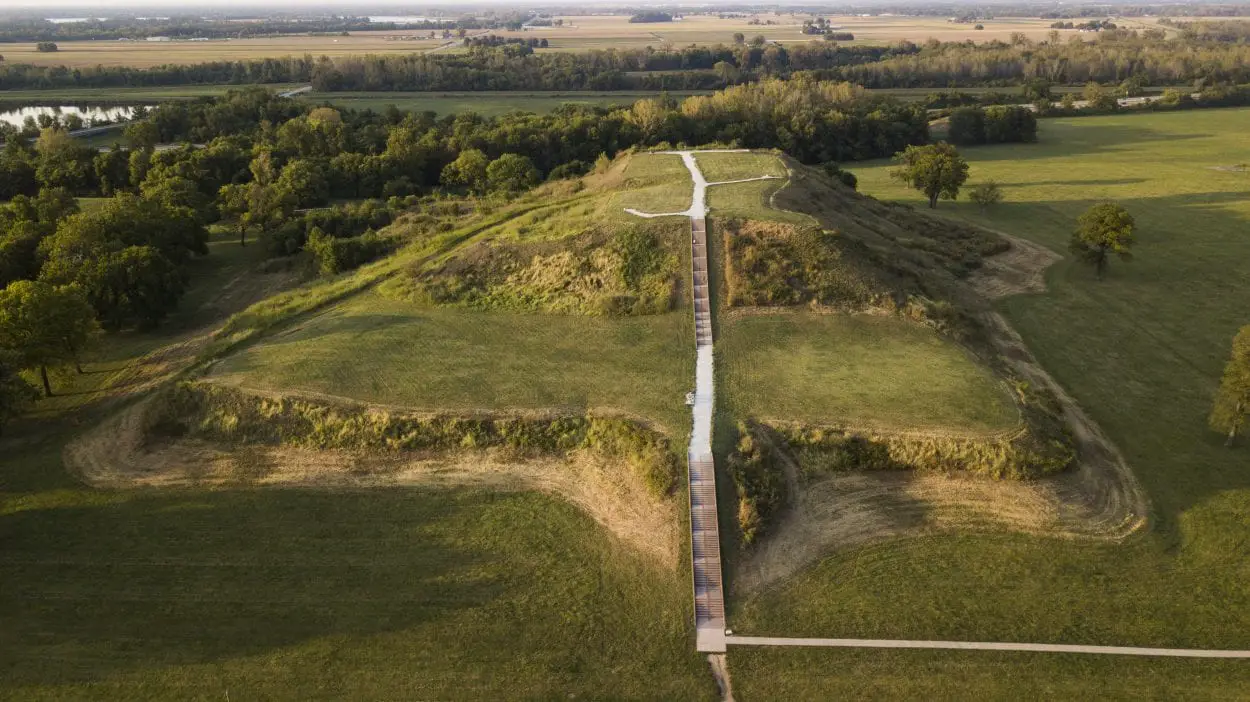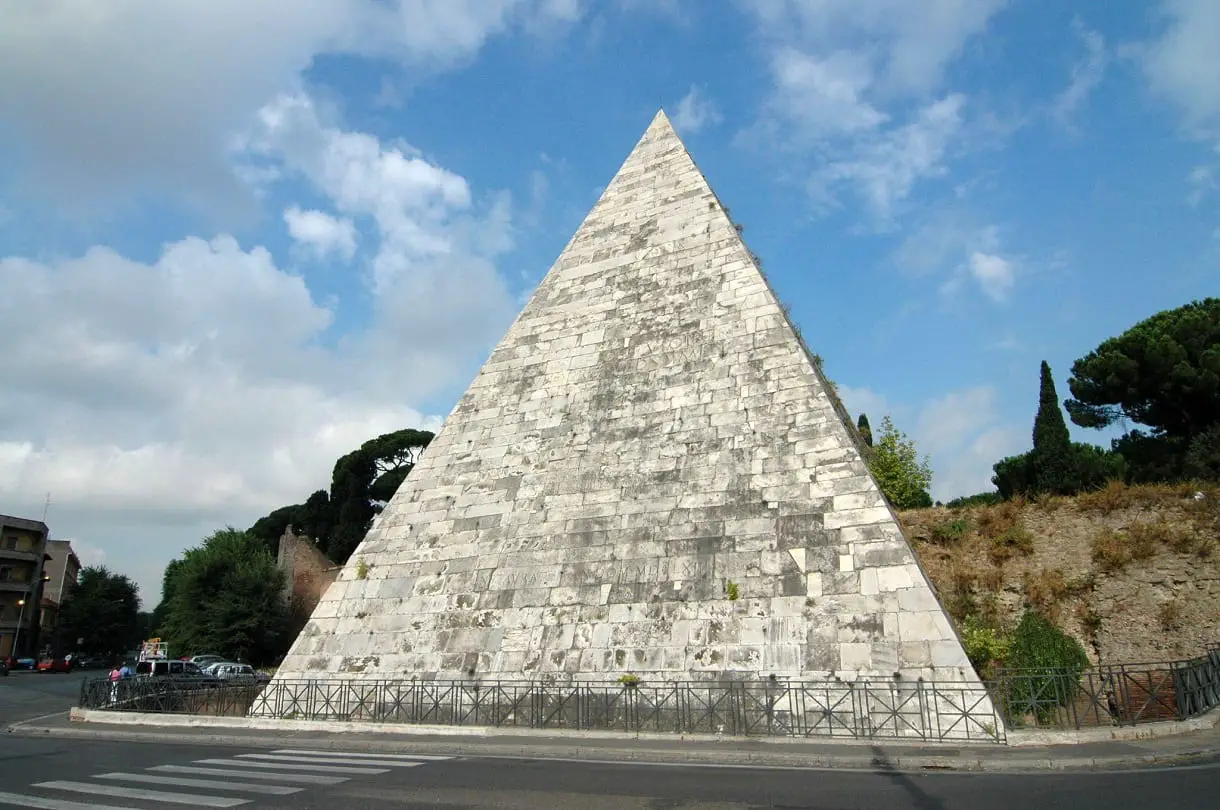A pyramid is a structure whose outer surfaces are triangular and converge to a single point at the top, making the shape roughly a pyramid in the geometric sense. The base of a pyramid can be trilateral, quadrilateral, or of any polygon shape.
For thousands of years, the largest structures on Earth were pyramids, constructed across the globe by various ancient civilisations, with the largest pyramid by volume being the Great Pyramid of Cholula, in the Mexican state of Puebla.
1 – Monte d’Accoddi – Sardina
Monte d’Accoddi is an ancient megalithic structure in northern Sardinia, Italy and dates from around c. 4,000-3,650 BCE. The structure was initially built by the Ozieri culture, a prehistoric pre-Nuragic civilisation that constructed more than 200 related archaeological sites.
The structure was damaged around 3000 BCE with archaeological evidence suggesting traces of burning as a possible cause. By 2800 BCE, the original structure was restored with additional platforms and a step pyramid that reached around 10 metres in height.
The pyramid is believed to be the earliest known sacrificial site in Western Europe, evident by the trace remains of sheep, cattle and swine in the chalcolithic Abealzu-Filigosa layers.

2 – Pyramids of Argolis – Greece
The Pyramids of Argolis, also referred to as the Greek Pyramids are pyramid-shaped monuments that are located in the Argolid plains in Greece. The most famous of these structures is the Pyramid of Hellinikon, described in the time of the geographer Pausanias as a tomb, but also referred more recently as a small garrisoned fort.
Archaeologists have struggled to accurately date the structures, as various methods of dating techniques have resulted in conflicting results. Further disputed research places the monuments from around 2000–400 BCE.

3 – Pyramid of Cestius – Italy
The Pyramid of Cestius is an ancient pyramid in Rome, Italy, near the Porta San Paolo and the Protestant Cemetery. It stands at a fork between two ancient roads, the Via Ostiensis and another road that ran west to the Tiber along the approximate line of the modern Via della Marmorata. Due to its incorporation into the city’s fortifications, it is today one of the best-preserved ancient buildings in Rome.
The pyramid was built about 18 BCE–12 BCE as a tomb for Gaius Cestius, a magistrate and member of one of the four great religious corporations in Rome, the Septemviri Epulonum. It is of brick-faced concrete covered with slabs of white marble standing on a travertine foundation, measuring 100 Roman feet (29.6 m) square at the base and standing 125 Roman feet (37 m) high.

4 – Kushite (Nubian) Pyramids – Sudan
The Kingdom of Kush was an ancient African kingdom located in Nubia, a region along the Nile rivers encompassing the areas between what is today central Sudan and southern Egypt. The region was home to three periods of Kushite development through antiquity. The first had its capital based at Kerma (2600–1520 BCE) which was Nubia’s first centralised state with an indigenous form of architecture and burial customs.
The second was centred on Napata (1000–300 BCE), with the last kingdom being centred at Meroë (300 BCE–300 CE). Both later Kingdoms saw a close influence develop from the customs and burial practices of Ancient Egypt. In the 8th century BCE, King Piye invaded Egypt and established the twenty-fifth dynasty of rule across the Egyptian Empire, uniting both kingdoms in the Nile valley that stretched from the delta to the city of Napata.
The twenty-fifth dynasty Pharaohs built or restored temples and monuments throughout the Nile valley, including Memphis, Karnak, Kawa, and Jebel Barkal. Their reign also saw the first widespread construction of pyramids not seen since the pharaohs of the Middle Kingdom.
After around 100 years of rule, control of Egypt and its territories ended after the invading conquests of the Assyrians who placed a native Egyptian ruler, Psamtik I on the throne. Kushite civilisation continued for several centuries until a series of crippling wars with the Roman Empire around the 1st to 2nd century CE would lead to a gradual decline. By the mid-sixth century CE the Kingdom of Kush was dissolved.
Archaeologists have accounted for more than 255 pyramids, built across four royal pyramid field sites in Nubia (El-Kurru, Nuri, Meroe & Jebel Barkal or Gebel Barkal).

5 – La Quemada Votive Pyramid – Mexico
La Quemada is a Mesoamerican complex in Mexico, comprised of numerous masonry platforms that was possibly the the legendary site of Chicomostoc, a Caxcan site, a Teotihuacán fortress, a Purépecha centre, a fort against Chichimeca intruders, a Toltec trading post, or simply the consequence of independent development and a city of all the native groups settling north of the Río Grande de Santiago.
On the south and southeastern sides of the complex is a high concentration of ceremonial constructions, some of which are complexes made up of sunken patio platforms and an altar-pyramid called the Votive Pyramid.

6 – Great Pyramid of Cholula – Mexico
The Great Pyramid of Cholula, also known as Tlachihualtepetl (Nahuatl for “artificial mountain”), is a huge complex located in Cholula, Puebla, Mexico. It is the largest archaeological site of a pyramid (temple) in the New World. The pyramid stands 55 metres (180 ft) above the surrounding plain, and in its final form it measured 400 by 400 metres (1,310 by 1,310 ft).
The pyramid is a temple that has traditionally been viewed as having been dedicated to the god Quetzalcoatl. The architectural style of the building was closely linked to that of Teotihuacan in the Valley of Mexico, although influence from the Gulf Coast is also evident, especially from El Tajín.

7 – Monks Mound, Cahokia – USA
Many pre-Columbian Native American societies of ancient North America built large pyramidal earth structures known as platform mounds. Among the largest and best-known of these structures is Monks Mound at the site of Cahokia in what became Illinois, completed around 1100 CE, which has a base larger than that of the Great Pyramid at Giza.
Its base circumference is larger than the Pyramid of the Sun at Teotihuacan. As a platform mound, the earthwork supported a wooden structure on the summit. Unlike Egyptian pyramids which were built of stone, the platform mound was constructed almost entirely of layers of basket-transported soil and clay.

8 – Sukuh, Java
Sukuh is a 15th-century Javanese-Hindu temple, located on the western slope of Mount Lawu on the border between Central and East Java provinces.
Sukuh temple has distinctive thematic reliefs where life before birth and sexual education are its main theme. Its main monument is a simple pyramid structure with reliefs and statues that includes three tortoises with flattened shells, a male figure grasping his penis and a 1.82 m tall phallus with four testes that represents penile incisions

9 – Prang, Koh Ker, Cambodia
Koh Ker is a remote temple site and former capital of the Khmer empire in northern Cambodia. The most distinct monument is the Prang, a seven‑tiered and 36-metre (118 ft) high pyramid, which most probably served as state temple during the reign of Jayavarman IV who ruled from 928 to 941 CE.
Originally on the top platform stood a huge lingam probably more than 4 m (13 ft) high and having a weight of several tons. Inscriptions say that it was the tallest and most beautiful Shiva-ling-am.

10 – Túcume, Peru
Túcume is a pre-Hispanic site in Peru, south of the La Leche River on a plain around La Raya Mountain. It covers an area of over 540 acres (220 ha) and encompassing 26 major pyramids and mounds.
Túcume is mainly the Lambayeque culture, a sub-group of late Sicán in the period from 1000 to 1350 CE, who settled here after they had given up their previous centre Poma, in the upper Leche Valley.

Header Image Credit : Francesco Gasparetti – CC BY 2.0





